Wai-Fah Chen.The Civil Engineering Handbook
Подождите немного. Документ загружается.

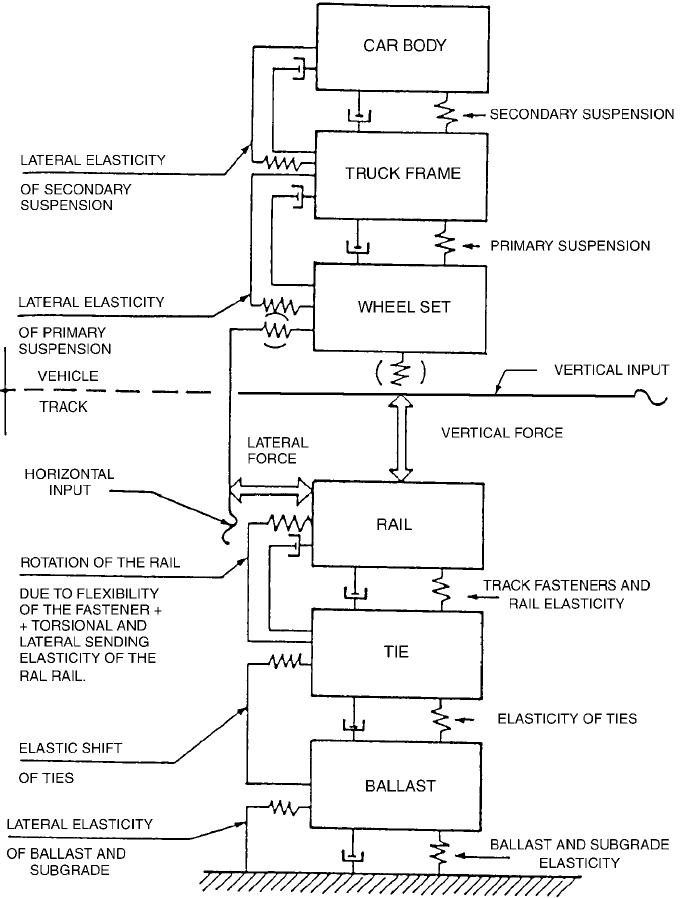
High-Speed Ground Transportation: Planning and Design Issues 60-25
one-sided improvement effort for vehicle design over track design through the years has shifted the effects
of the two coefficients on the total dynamic loading impact. At present, the dynamic impact loading
factor (I
t
) is affected almost entirely by track irregularities and stiffness (I
s
) of the rail, ballast, and
subgrade; thus, the track tolerances are specified as tightly as possible within financially feasible limits
[47]. Controlling the impact of dynamic loading is essential in HSR systems and mainly requires uni-
formity of subgrade.
It is clear from published track force and acceleration data derived from high speed test runs and from
instrumented trainsets in commercial service that the TGV trucks are stable even at very high speed,
FIGURE 60.13 Tr ack–train system for dynamic analysis of forces. (From U.S. Government Accounting Office, Report
to the Chairman, Committee on Energy and Commerce, High-Speed Ground Transportation: Issues Affecting
Development in the United States, House of Representatives, November 1993.)
© 2003 by CRC Press LLC
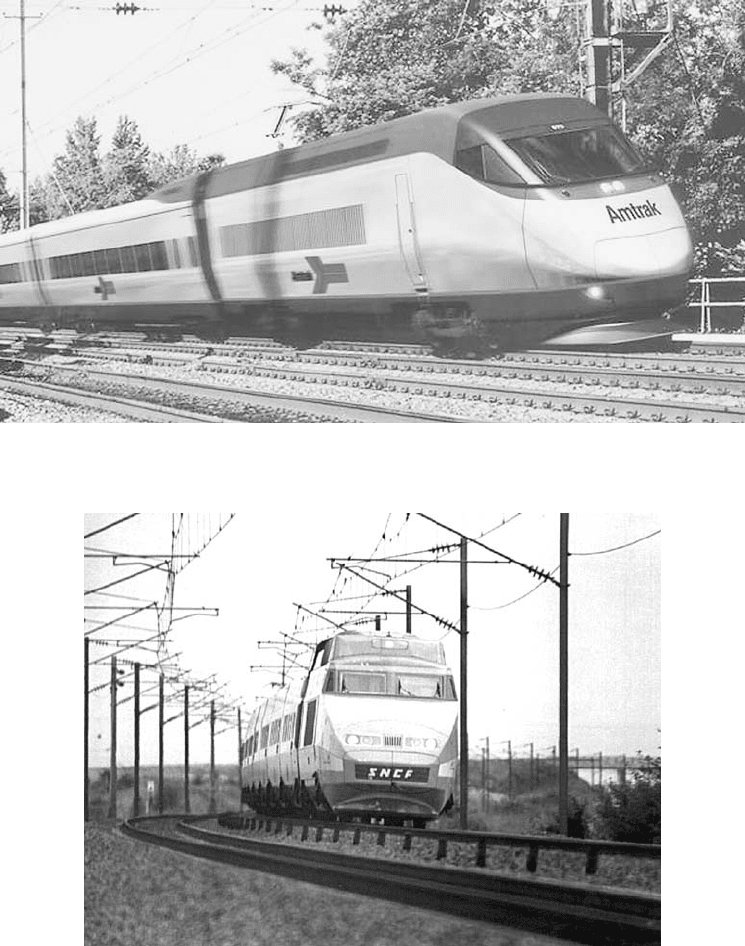
60-26 The Civil Engineering Handbook, Second Edition
and that the dynamic force and acceleration levels are well within limits established by SNCF. … For
the December 1989 test run at 482 kph, the measured maximum vertical accelerations were 3 g to 4 g
at the tie and 1 g to 1.5 g in the ballast, about the same as those measured for a conventional locomotive-
hauled passenger train at 200 kph and well within established limits. Measured lateral force reached
a maximum of 48 kN. In fact, the lateral resistance of the TGV track, which uses concrete ties and
dynamic stabilization, is more than double the Prud’homme limit [126 kN vs. 57 kN]. [12,14].
FIGURE 60.14 Picture of ACELA Express. (From Railway Technology website, www.railway-technology.com.)
FIGURE 60.15 The original TGV. (From Dechamps, F.)
© 2003 by CRC Press LLC

High-Speed Ground Transportation: Planning and Design Issues 60-27
60.6 HSR Examples Worldwide
Introduction
Unlike in the United States, where HRS implementation is still in the planning phases (except for the
ACELA HSR, which started operating in 2000), in other places of the world (Europe and Asia), HSR
trains are either operating or in the phase of near future implementation. Such systems will be discussed
in the following paragraphs.
United States: The ACELA Express [12,20]
ACELA is the first HSR train to be used in the United States. It was because of Amtrak’s efforts since
1996 to improve its operations in the Northeastern corridor from Washington, D.C., to Boston, where
the company holds about 45% of the passenger market, that it was decided to put an HSR train into
service. It was also decided that existing tracks would be used and that with some upgrades tilt technology
would be implemented. Also, the whole corridor would be electrified (completed in late 1999). The
service started operating in December 2000. The ACELA managed to cut the time from Boston to New
Yo rk from 4 h 30 min to a little more than 3 h.
The ACELA train set is based on the TGV, but it is largely constructed in the United States. It was
unveiled in March 1999 after a number of controversies that delayed its appearance. It should be noted
that TGV technology was finally selected after examining the German ICE technology and the Swedish
X2000 tilt technology. (Both train sets were demonstrated in the United States in 1993). The building of
the ACELA train set started in 1998, along with the NEC modifications. As for the ACELA train set
technology, it was based on used and proven technologies. The ACELA can achieve speeds of 150 mph
and has a length of 202 m and a weight of 566 tonnes. Its configuration is that of 1 power car, 6 cars,
and another power car, giving it the ability to carry 304 passengers. The six cars consist of one first-class
car, four business-class cars, and a dining car.
The ACELA uses the third-generation TGV traction technology and tilt technology in its suspensions
(up to 6.5 degrees), and it complies with the FRA’s standards on possible crushes, which are the toughest
around the world. For that reason, the ACELA is significantly heavier than other HSR trains worldwide
(45% heavier than the TGV). The signaling and safety systems, as well as the monitoring system, are also
technologically advanced, to ensure maximum safety on the existing corridor.
France: The TGV [12,14]
The TGV (Train Grande Vitesse) is the French HSR train. Since there are significant differences among the
350 train sets based on the TGV, a more appropriate term would be “a system which comprises train, track
and signaling technologies that when combined, allow the train to achieve high speeds (300 kph)” [14].
TGV is owned by Societe Nationale de Chemins de Fer Francais (SNCF), the French national railways,
and it is an integral part of French rail travel.
When developing the TGV, SNCF wanted a train to be able to use existing tracks on high speeds,
especially in main cities, where new tracks would be difficult to construct and expensive. The first
prototype of the TGV train set began testing in the early 1970s. The first line to be operated by the TGV
was completed and started operation in 1981, connecting Paris with Lyon. Its success gutted the
Paris–Lyon airline connection and freed the expressway connecting the two cities. The TGV became one
of the few parts of SNCF that gained profit, and within ten years of its initiation, it had completely paid
for itself. Since 1981, new lines have been built in France and neighboring countries. TGV Atlantique
was initiated in 1989, connecting Paris with western points of France. Today there are three major lines,
with Paris at their center. The most recent line connects Paris to Lille, Belgium, the Netherlands, Germany,
and Britain (through the Channel tunnel). TGV technology is also applied in other countries.
© 2003 by CRC Press LLC
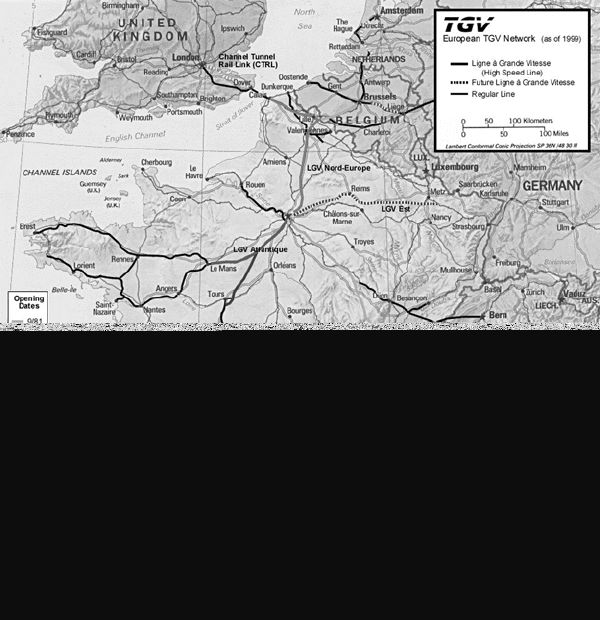
60-28 The Civil Engineering Handbook, Second Edition
TGV is a lightweight train. Its special placement of articulation (a truck between trailers instead of
two tracks in each trailer) reduces noise, provides more space and a higher plane for the suspension, and
improves aerodynamics. Some of its technological advantages are the special pantograph and the onboard
signaling information (since it is impossible to watch signs next to the track when traveling at speeds of
300 kph). TGV-dedicated lines are of no special construction, just heavier ballast to hold the track and
higher radii combined with appropriate superelevation. The TGV holds the record for the fastest train
in the world, achieving a speed of 515.7 kph in 1990. There have been no accidents within its 20 years
of operation, only the incidents mentioned earlier.
An important project linked to the TGV technology is Thalis (PBKA), a European high-speed service
connecting Paris (France), Brussels (Belgium), Amsterdam (the Netherlands), Koln (Germany), and other
European destinations. It is a semiprivatized commercial operation and an effort of the several railway
agencies of European countries to cooperate. The project began in 1996. Trains are based on TGV
technology, achieve maximum speeds of 300 kph (186 mph), and can carry up to 377 passengers. Their
configuration consists of two power cars and eight trailers. Advanced technology was applied to ensure
compatibility between the systems used by different countries.
Germany: The ICE [12,13]
Germany was behind other European countries in HSR up to 1992, but with the development of the ICE
(Intercity Express), it managed to make up for the lost time. The first lines connected Hanover and
Wurzburg, and Mannheim and Stuttgart, in 1992. Other ICE services connected Hamburg, Hanover,
Fulda, Frankfurt, Mannheim, Stuttgart, and Munich in the following years. The operating speed of the
FIGURE 60.16 The TGV network map. (From French TGV web information (TGVWeb), mercurio.iet.unipi.it/tgv,
Italy, 2001.)
© 2003 by CRC Press LLC
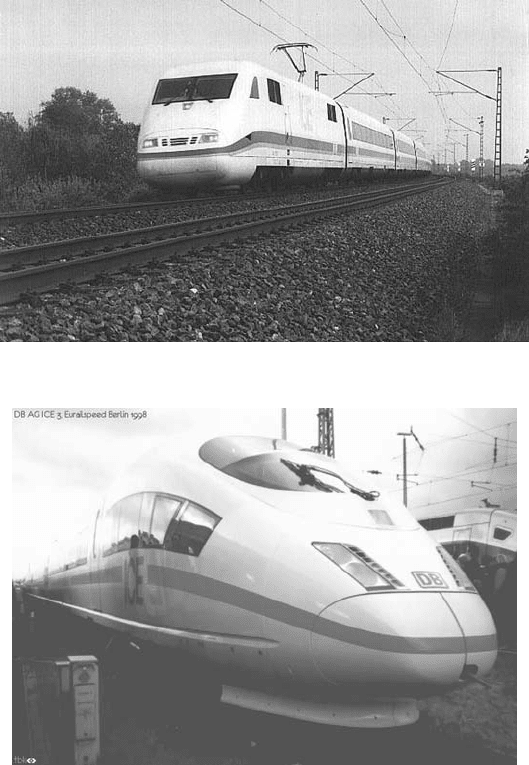
High-Speed Ground Transportation: Planning and Design Issues 60-29
ICE trains in these lines is 250 kph (280 kph if late). To service these lines, 60 ICE-type (ICE1) train sets
were built. The train set design was updated into ICE2, ICE3, and ICE-T tilting trains. Along with the
train set development, the network expanded, including East Germany lines in 1997 and destinations in
the Netherlands, Switzerland, and Austria, as well as many more destinations in Germany.
ICE aimed for long-distance passengers (75 km more than the trip of an average passenger). Within
its first two years of operation, the ICE brought an additional 1.3 million passengers per year. Lufthansa,
the German airline, bought part of the ICE company and canceled flights within Germany, rerouting
passengers to rail transportation. The ICE types 1, 2, and 3 are able to achieve speeds up to about 415 kph.
They use nondedicated lines. They have electrical as well as diesel capabilities and use technology
advanced over the scope of this chapter. ICE trains are serving in other places worldwide.
Japan: The Shinkansen (Bullet Train) [12,19,65]
High-speed railways were born in Japan. The Japan network has been developed over the past 37 years
and covers all main routes. At the moment, the network has Tokyo as the center and lines extend to the
north and west of the country. The first line to operate (Tokaido Shinkansen) was the Tokyo–Osaka line
in 1964, at a speed of 200 kph, later increased with improvements in the infrastructure, signaling, and
FIGURE 60.17 ICE type 1. (From Kroczek, O., 1998.)
FIGURE 60.18 ICE type 3. (From Kølher, T., 1998.)
© 2003 by CRC Press LLC
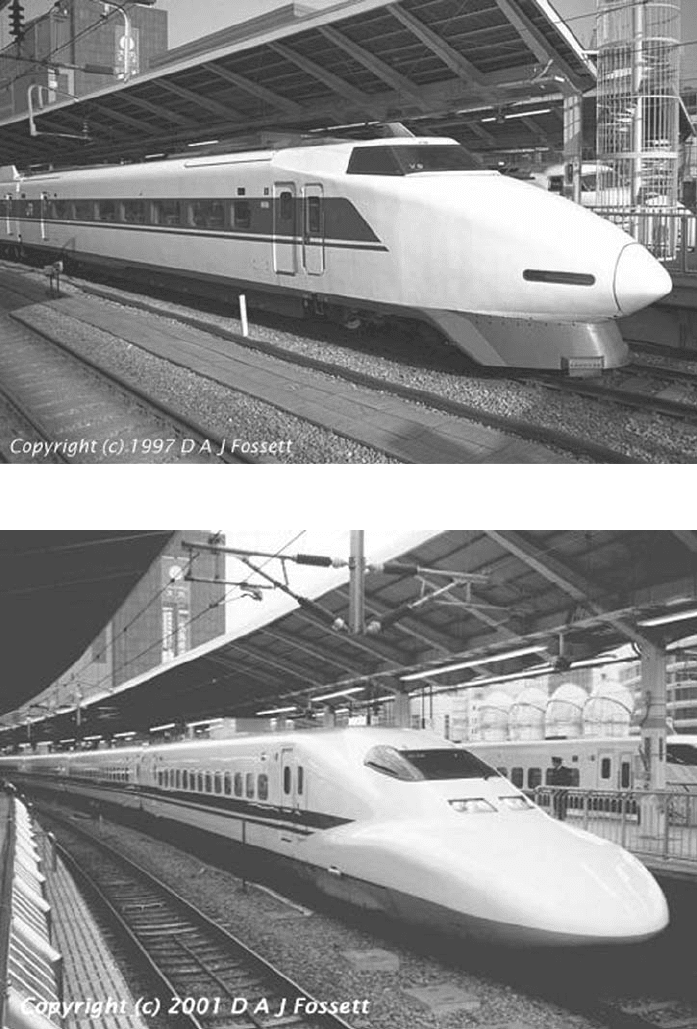
60-30 The Civil Engineering Handbook, Second Edition
maintenance. In 1972, the second generation of bullet trains was introduced, connecting Shin-Osaka and
Okayama, to be extended 3 years afterward to Hakata. The north of the country operated its first
Shinkansen in 1982, to Morioka (Tohoku Shinkansen) and Niigata (Joetsu Shinkansen). Further expan-
sions northbound were made in the following years. In 1987, the Japanese National Railways were
privatized and separated into two companies, JR West and JR Central. At the moment, Japan has more
FIGURE 60.19 Shinkansen type 100. (From Fossett, D.A.J.)
FIGURE 60.20 Shinkansen type 700. (From Fossett, D.A.J.)
© 2003 by CRC Press LLC
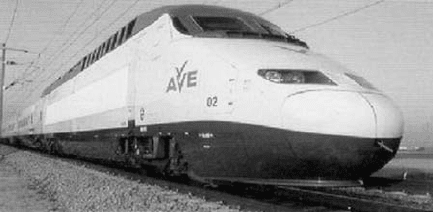
High-Speed Ground Transportation: Planning and Design Issues 60-31
than 1500 miles of HSR-dedicated lines. The Japanese HSR serves around 400,000 passengers daily and
has an on-time arrival record of 99% [24].
There have been several models of the Shinkansen in the 37 years of its service (0, 100, 300, 500, and
variations). Trains use dedicated lines in high speeds (operating at around 300 kph). The Shinkansen
trains have shown higher levels of safety than any other transportation mode. Of the train sets, the more
advanced is the 500 series Nozomi that, according to its builders, achieves an excellent balance of train
performance, passenger comfort, and environmental friendliness. The Nozomi is capable of operating
at a speed of 300 kph and carrying approximately 1320 passengers, more than two times the passenger-
carrying capability of a Boeing 747-400 airplane.
As for the Shinkansen’s market success in Japan, the first line between Tokyo and Osaka (320 miles)
is a bright example. The Shinkansen has captured around 80% of the market of trips between the two
cities. The line was built on a complete grade-separated line and exclusive ROW. Sixty-six tunnels and
more than 3100 bridges were built to facilitate the ROW.
Other Examples
Based upon the TGV, ICE, and Shinkansen models, other countries have or are developing at the moment
HSR networks worldwide:
• Spain uses the AVE HSR network [12], which during the 1990s linked key cities of the country.
The first link connected the 417-km distance between Madrid and Seville (since Seville was hosting
the World Expo in 1992 and was also a popular destination for French visitors). Soon, links to
Barcelona and the French border were constructed, stretching to other cities, as well. The Spanish
HSR trains are close relatives of the TGV, offering high-quality services to their passengers to
withstand the intense competition with airlines on the same routes. In addition to the AVE, Spanish
Railways (RENFE) introduced in 1999 tilting trains (which have a different gauge than the AVE)
in the existing and busy route between Madrid and Valencia. ETR 460 Italian-type trains are used,
with a configuration of two power cars and a single trailer, being able to carry 160 passengers.
These trains have a maximum speed of 220 kph and travel the distance of 489 km between Madrid
and Valencia in 3 h 15 min.
•The Eurostar Italia is the HSR’s latest generation of Italy’s rail [12]. It is serviced by the ETR 500
nontilting high-speed train. Three routes have been upgraded: the Bologna–Firenze route, the
Rome–Naples route, and the Milan–Bologna route, allowing ETR 500 train sets to achieve speeds
of 300 kph. The train sets are operating around routes that connect Italy’s fastest-growing cities,
like Rome, Naples, Florence, Bologna, Genoa, and Venice, where more than 50% of the country’s
population lives. The ETR 500 is a 13-vehicle unit that can accommodate 590 passengers and can
achieve a maximum speed of 300 kph. There are 60 train sets programmed to service the routes,
more than half of which were built in 2000. The ETR 500 has automatic control and protection
systems and provides and offers extended services to its passengers.
FIGURE 60.21 AVE picture. (From AVE web page, http://mercurio.iet.unipi.it/ave.)
© 2003 by CRC Press LLC

60-32 The Civil Engineering Handbook, Second Edition
•In China the largest engineering project at this time is the HSR connection between the two largest
cities of the country, Beijing and Shanghai [12]. The distance between the two cities is 1307 km,
and the separate corridor is expected to boost growth to the rest of the country. The corridor will
be operating at 350 kph. Two-thirds of the corridor will be on embankments, while the rest will
be mostly bridges. Chinese construction train sets will be used for the project.
• VIA rail, Canada’s national rail corporation, found that high-speed rail is technically feasible, is
financially attractive, and can result in significant user benefits. Three corridors (Quebec
City–Windsor, Montreal–Ottawa–Toronto, and Toronto–Windsor) were examined regarding their
HSGT system potential, but only the Quebec City–Windsor corridor seemed promising. This
corridor is about 700 miles long and contains a population of 15 million, which is approximately
half of Canada’s population. In this study VIA indicated that high-speed rail can succeed in
capturing sufficient ridership in the medium distance (250 to 350 miles) if it offers door-to-door
times that are comparable to that of air transport.
•Other projects like TGV Korea plan to connect Seoul with Pusan with HSR TGV technology
[12,14]. The Taiwan HSR project will link the two ends of the island with trains traveling at 300
kph, using hybrids of both TGV and ICE technologies [12] on a corridor of 345 km, almost
completely through tunnels and viaducts. The Swedish network is based on the X2000 tilting trains
that operate at 200 kph and the Arlanda Express, which operates at the same speeds. The Australian
HSR (Speedrail) project, connecting Sydney and Canberra with TGV technology trains moving
at 320 kph, is expected to be completed in late 2004 [12] and later expanded to other cities of the
country [12].
60.7 Magnetic Levitation Technology
Using magnetic levitation for suspension and propelling by means of electric fields is one technology
that has been considered as a replacement for the conventional steel-wheel-on-steel-rail technology. The
technology is referred to as MAGLEV [1,66–70]. Without the friction, higher speeds are possible, but
the system requires a specially designed guideway, often elevated. The “father of electromagnetic levita-
tion,” Herman Kemper, began his research on the subject in 1922, with a basic patent granted in 1934 [1].
The patent was proof of magnetic levitation and resulted in a model that could carry a load of 450 pounds.
The research on magnetic levitation and its application to passenger transport have come a long way
since, with the German government initiating an in-depth examination of the feasibility, safety, and
planning issues of such a system in the 1970s [66,69,70]. At about the same time, the Japanese National
Railways started conducting their own research at RTRI.
The German study pointed out that MAGLEV technology could be very successful, in terms of
passenger traffic, for medium- and long-distance routes [1]. Planners have calculated that the construc-
tion cost of a MAGLEV system would be about 30% higher than that of the steel-wheel-on-steel-rail
system. Germany took a careful look at the prospect of initiating a MAGLEV line at the Hamburg–Berlin
route to accommodate the considerable increase in passenger traffic due to the 1991 unification of
Germany. It is worth noting that the interest from the industry in MAGLEV technology was such that
private capital would be incorporated into the public infrastructure through the construction of the
MAGLEV line. The name of the train set, which was further developed in the following years, was
Tr ansrapid [1]. The project was expected to be completed in 2006. After quite a few drawbacks and
problems in the financial viability of the project and lack in political will to implement it (despite the
continuous technological advancement of the MAGLEV train set), the project was canceled in February
2000, only 6 months before its construction was supposed to begin. The alignment would have consisted
of a 292-km double track (55% at grade, 45% elevated), 5 stations, and 11 propulsion system substations.
At the time, within Germany, five new projects are being examined and feasibility studies are being
conducted. The final decision will be taken in late 2002. Meanwhile, the eighth generation of Transrapid
carried around 50,000 paying passengers to visit the World Expo 2000 Exhibition in Hanover. Transrapid
© 2003 by CRC Press LLC
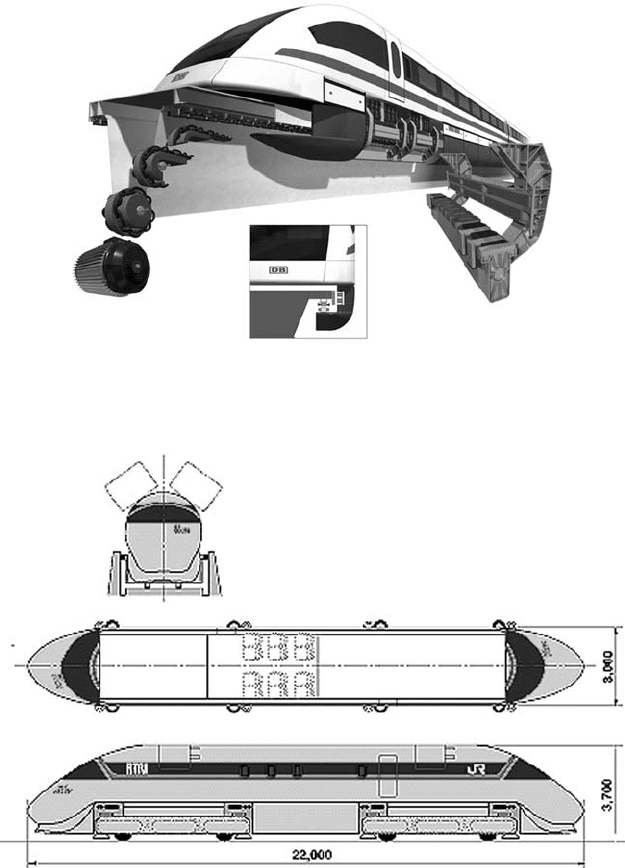
High-Speed Ground Transportation: Planning and Design Issues 60-33
feasibility and implementation studies are also being conducted around the world. The first project to
be completed in a few years is the connection of the Shanghai Airport with Shanghai, China. The Chinese
are also considering construction of MAGLEV lines from Shanghai to Beijing (1307 km) instead of
applying an HSR corridor of the conventional type. In the United States, TEA 21 will be funding feasibility
and implementation studies of the Transrapid in the California–Nevada (Las Vegas–Barstow–Ontario
County, California North–South), Florida (Orlando–Port Canaveral), Pennsylvania, and Balti-
more–Washington, D.C., corridors.
As for Japanese MAGLEV trains, called MLU [74], the Japanese have been testing them and developing
their technology from time to time. The only track existing in Japan is a 7-km test track. The latest MLU
vehicle (five cars) managed to achieve a speed of 552 kph (manned vehicle) in the test track in April
1999 [67].
FIGURE 60.22 Transrapid figure and technology. (From Transrapid website, www.transrapid-international.de/en,
Germany, 2001.)
FIGURE 60.23 MLU design. (From RTRI.)
© 2003 by CRC Press LLC
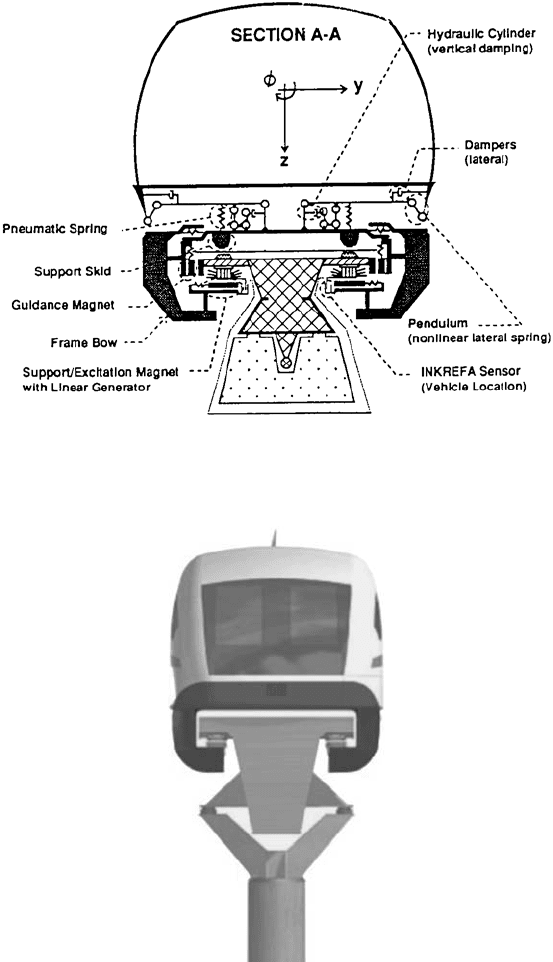
60-34 The Civil Engineering Handbook, Second Edition
MAGLEV technology differs significantly from that of steel-wheel-on-steel-rail. The Transrapid (the
name of the German MAGLEV system) vehicles are magnetically levitated and guided within a guideway,
as shown in Fig. 60.26. They are propelled by synchronous linear motors along a guideway. Levitation
forces are generated by magnets on the undercarriage, or levitation frame, below the guideway beam.
Guidance magnets are also mounted on the undercarriage but face the outer edges of the guideway, thus
keeping the vehicle aligned with the guideway. Each car has a series of levitation frames, which align
magnets and carry the levitation and guidance forces to the car body through pneumatic springs and
links. When the levitation magnets are energized, the vehicle is lifted toward the guideway [67]. The
FIGURE 60.24 Transrapid TR-07 MAGLEV train. (From Galanski, R.A., Safety of High Speed Guided Ground
Transportation Systems: Collision Avoidance and Accident Survivability, DOT/FRA/ORD-93/2.III, March 1993.)
FIGURE 60.25 Transrapid track. (From Transrapid website, www.transrapid-international.de/en, Germany, 2001.)
© 2003 by CRC Press LLC
